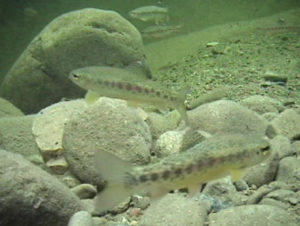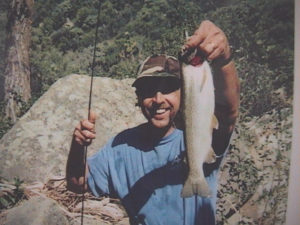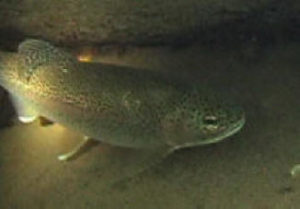
Juvenile steelhead in the South Fork Sisquoc River. Photo © Matt Stoecker
Officials with the State of California have launched a long-awaited study of the Santa Maria River system to determine what measures should be taken to restore historic water flows. Periodic flows would allow endangered steelhead trout to migrate upstream and access historic spawning grounds in the Sisquoc River, deep inside the San Rafael Wilderness in the Los Padres National Forest.
The Sisquoc River and its tributaries, including Manzana Creek, once supported the second-largest steelhead run in Santa Barbara County (the Santa Ynez River’s run of 25,000 fish was the highest). Early pioneers as far back as 1879 reported hundreds of steelhead in pools, so numerous that one could catch trout with their bare hands. A historic cabin along the Sisquoc River contains charcoal sketches of large fish, along with the dates and names of the anglers who caught them, some measuring more than 24 inches long. A newspaper article in 1941 reported that five steelhead were caught on a downtown Santa Maria street when the river overflowed its banks.

Adult steelhead caught (and released) on the Sisquoc River in 1998.
However, the construction of Twitchell Dam in the 1950s effectively turned off the spigot in this river system. The dam is designed to replenish groundwater supplies, and does so by trapping all streamflow during the winter and spring and slowly releasing it during the summer. This schedule usually leaves no water for steelhead during the times they would normally migrate upstream, in the winter and the spring. For steelhead, adequate streamflows are a lifeline between the ocean (where steelhead mature) and spawning areas in the upper watershed, where they deposit their eggs.
The National Marine Fisheries Service – the top federal agency charged with protecting steelhead populations – recently released a draft Recovery Plan for southern steelhead. It lists the Santa Maria/Sisquoc River system as the highest priority for recovery actions, and recommends providing adequate streamflows for steelhead. In addition, longstanding California law requires that all dams provide enough streamflow to maintain downstream fish populations.

16-inch steelhead in the Sisquoc River
Currently, nobody knows exactly how much water is needed to sustain a steelhead fishery. Due to this lack of data, the State of California has included the Sisquoc/Santa Maria River system as one of three rivers it will study in the coming years. The goal of the study is to determine how much water is needed to support a steelhead population in this river system. The study will be completed in 2012.
It’s a perfect time to begin gathering data that will help all stakeholders make informed decisions about water use in this system. Such measures may eventually include water conservation, adjustments to the dam’s water release schedule, or others.
ForestWatch attended the first public hearing on this study in November 2010, and will continue to track the process to ensure that steelhead can once again reach their historic spawning grounds in the Los Padres National Forest.

June 30, 1879. “The stream is full of mountain trout. I am confident that we saw in some places more than 500 at one sight. We were disappointed in the remembrance of leaving our hooks with the wagons, but had no difficulty in capturing all we wanted with our hands, averaging a pound each.”
Benson, Arlene. The Noontide Sun: The Field Journals of the Reverend
Stephen Bowers, Pioneer California Archeologist. Ballena Press. 1997. Pg 136.
More info:







Comments are closed.